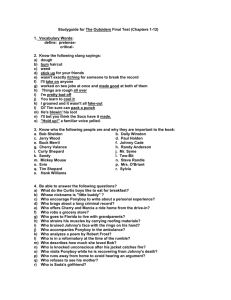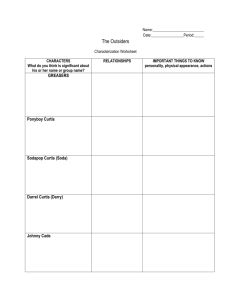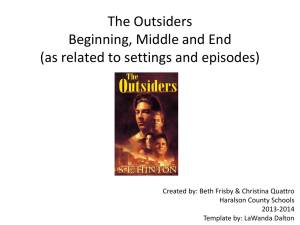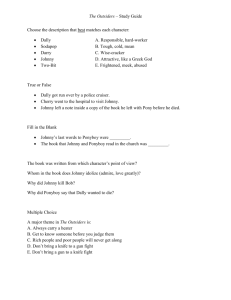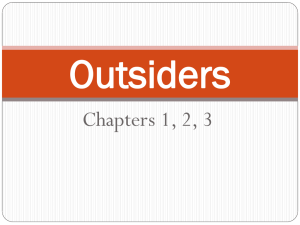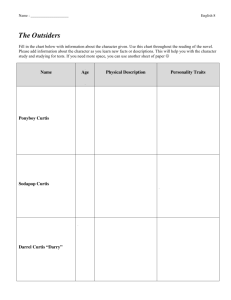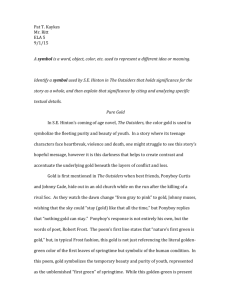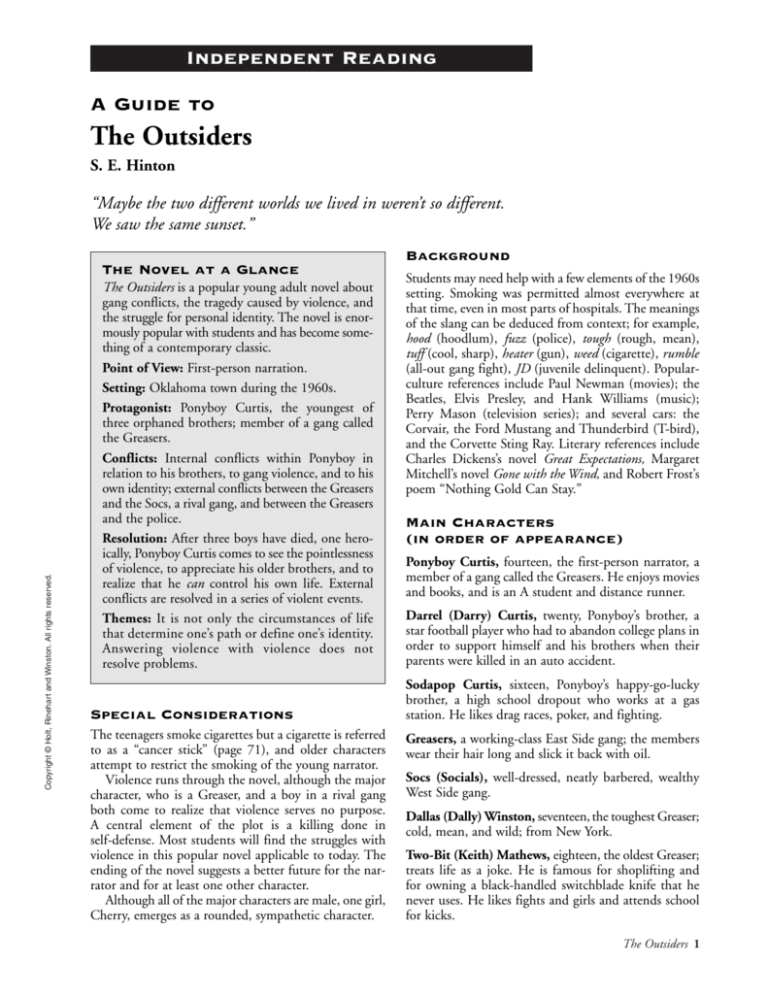
Independent Reading
A Guide to
The Outsiders
S. E. Hinton
“Maybe the two different worlds we lived in weren’t so different.
We saw the same sunset.”
Background
Copyright © Holt, Rinehart and Winston. All rights reserved.
The Novel at a Glance
The Outsiders is a popular young adult novel about
gang conflicts, the tragedy caused by violence, and
the struggle for personal identity. The novel is enormously popular with students and has become something of a contemporary classic.
Point of View: First-person narration.
Setting: Oklahoma town during the 1960s.
Protagonist: Ponyboy Curtis, the youngest of
three orphaned brothers; member of a gang called
the Greasers.
Conflicts: Internal conflicts within Ponyboy in
relation to his brothers, to gang violence, and to his
own identity; external conflicts between the Greasers
and the Socs, a rival gang, and between the Greasers
and the police.
Resolution: After three boys have died, one heroically, Ponyboy Curtis comes to see the pointlessness
of violence, to appreciate his older brothers, and to
realize that he can control his own life. External
conflicts are resolved in a series of violent events.
Themes: It is not only the circumstances of life
that determine one’s path or define one’s identity.
Answering violence with violence does not
resolve problems.
Special Considerations
The teenagers smoke cigarettes but a cigarette is referred
to as a “cancer stick” (page 71), and older characters
attempt to restrict the smoking of the young narrator.
Violence runs through the novel, although the major
character, who is a Greaser, and a boy in a rival gang
both come to realize that violence serves no purpose.
A central element of the plot is a killing done in
self-defense. Most students will find the struggles with
violence in this popular novel applicable to today. The
ending of the novel suggests a better future for the narrator and for at least one other character.
Although all of the major characters are male, one girl,
Cherry, emerges as a rounded, sympathetic character.
Students may need help with a few elements of the 1960s
setting. Smoking was permitted almost everywhere at
that time, even in most parts of hospitals. The meanings
of the slang can be deduced from context; for example,
hood (hoodlum), fuzz (police), tough (rough, mean),
tuff (cool, sharp), heater (gun), weed (cigarette), rumble
(all-out gang fight), JD (juvenile delinquent). Popularculture references include Paul Newman (movies); the
Beatles, Elvis Presley, and Hank Williams (music);
Perry Mason (television series); and several cars: the
Corvair, the Ford Mustang and Thunderbird (T-bird),
and the Corvette Sting Ray. Literary references include
Charles Dickens’s novel Great Expectations, Margaret
Mitchell’s novel Gone with the Wind, and Robert Frost’s
poem “Nothing Gold Can Stay.”
Main Characters
(in order of appearance)
Ponyboy Curtis, fourteen, the first-person narrator, a
member of a gang called the Greasers. He enjoys movies
and books, and is an A student and distance runner.
Darrel (Darry) Curtis, twenty, Ponyboy’s brother, a
star football player who had to abandon college plans in
order to support himself and his brothers when their
parents were killed in an auto accident.
Sodapop Curtis, sixteen, Ponyboy’s happy-go-lucky
brother, a high school dropout who works at a gas
station. He likes drag races, poker, and fighting.
Greasers, a working-class East Side gang; the members
wear their hair long and slick it back with oil.
Socs (Socials), well-dressed, neatly barbered, wealthy
West Side gang.
Dallas (Dally) Winston, seventeen, the toughest Greaser;
cold, mean, and wild; from New York.
Two-Bit (Keith) Mathews, eighteen, the oldest Greaser;
treats life as a joke. He is famous for shoplifting and
for owning a black-handled switchblade knife that he
never uses. He likes fights and girls and attends school
for kicks.
The Outsiders 1
Plot
Chapter 1. As Ponyboy Curtis is walking home from a
movie, five members of a gang called the Socs pull up
in a Corvair and jump him. He is rescued by his brothers and members of his own gang, the Greasers. With
this opener, the first-person narrator, Ponyboy, introduces us to the characters and their setting. We learn
who the Greasers and Socs are. We also learn that
Ponyboy loves movies and books and that he feels close
to his middle brother, Sodapop, but believes he cannot
please his big brother, Darry. We notice hints of conflicts
and problems to come: The Socs have already beaten up
a younger member of the Greasers, Johnny Cade, and
the orphaned Curtis brothers will be allowed to stay
together only as long as they do not get into trouble.
Chapter 2. We learn more about the characters and
the gangs. Dally, Johnny, and Ponyboy sneak into the
section of a drive-in movie theater reserved for people
who have not arrived in cars. Dally harasses two Soc
girls who are sitting there because they refused to stay
with their drunken Soc boyfriends. Eventually Dally
leaves. Ponyboy and Johnny strike up conversations
with the girls, Marcia and Cherry, and Two-Bit joins
them. In a flashback we learn that Johnny is habitually
scared because his father beats him and because four
Socs driving a blue Mustang left him seriously injured
four months earlier.
Chapter 3. Suspense builds when Soc boys in a blue
Mustang confront Two-Bit, Johnny, and Ponyboy, who
are walking Marcia and Cherry to Two-Bit’s house so
that he can drive the girls home, across town. We find
out that Bob is the Soc who beat up Johnny four
months earlier. A fight is averted when Cherry and
Marcia agree to let the Soc boys drive them home.
Ponyboy and Johnny stay out so late that when
Ponyboy gets home, his brother Darry slaps him.
Believing that Darry hates him, Ponyboy runs back
outside to Johnny.
Chapter 4. The Greaser-Soc conflict escalates to crisis.
In the middle of the night in the town park, the Soc
boys again confront Johnny and Ponyboy. A tall boy
holds Ponyboy’s head in the cold park fountain so long
that he almost drowns. Then Ponyboy finds himself
gasping on the pavement, and the Socs gone except for
Bob, who lies dead. Fearing for Ponyboy’s life, Johnny
2 The Outsiders
has stabbed Bob. Ponyboy and Johnny go to Dally
Winston for money, a gun, and a plan. At Dally’s direction, they hop a freight train to the next town and walk
to an abandoned church that Dally has told them
about. On reaching the church, Ponyboy has a premonition, a creepy feeling about the church that foreshadows more trouble.
Chapter 5. Johnny buys supplies in the nearby town,
and he and Ponyboy disguise themselves by cutting
their hair and bleaching Ponyboy’s. For four days they
eat bread and baloney, play poker, read the novel Gone
with the Wind, enjoy the view and the sunrise, and talk
about Robert Frost’s poem “Nothing Gold Can Stay.”
Dally Winston, who has tricked the police into thinking that the boys are headed for Texas, arrives on the
fifth day. He brings a letter from Sodapop Curtis that
speaks about Darry’s concern for Ponyboy. Dally takes
the boys into town for a full meal and tells them about
the complications that have arisen from the killing:
All-out Soc-Greaser warfare is developing, and Cherry
Valance is acting as a spy among the Socs on behalf of
the Greasers because she feels the killing was her fault.
Chapter 6. Johnny proposes turning himself in, since
Cherry and Ponyboy will testify that he acted in selfdefense. Dally, worried that jail time will harden
Johnny, tries to dissuade him. The story reaches a climax
when the trio return to the hide-out. They find the old
church ablaze; several eight-year-olds who were attending a school picnic are trapped inside. Believing they
may have started the fire by leaving a cigarette burning,
Ponyboy and Johnny break a window, locate the children, and drop them through another window to safety.
As the roof of the church caves in, Ponyboy escapes but
Dally burns his arm reaching into the building to drag
out the badly injured Johnny. In the ambulance, the
schoolteacher, Jerry Wood, is impressed with the three
of them and asks Ponyboy if they are “professional
heroes.” In the hospital, Ponyboy wakens to see his
brother Darry crying. Ponyboy realizes that Darry’s frequent scolding is his way of expressing his love.
Chapter 7. Reporters interview the Curtis brothers and
the headline says of Johnny, Ponyboy, and Dally,
“Juvenile Delinquents Turn Heroes.” Dally is expected
to recover from his arm burns, but Johnny remains in
critical condition with a broken spine, third-degree
burns, and severe shock. Ponyboy is released from the
hospital and goes home with his brothers. A rumble, or
gang fight, between the Socs and the Greasers is
planned for the next night. In the morning his brothers
go to work and Ponyboy spends the day with Two-Bit.
They run into the Soc boy Randy Adderson, who tells
Ponyboy he is tired of all the fighting and plans to leave
town. Randy describes the dead boy, Bob, as his best
friend, and as someone so spoiled that all he really
wanted was someone to say “No” to him. Ponyboy at
last understands what Cherry meant when she said earlier, “Things are rough all over.”
Copyright © Holt, Rinehart and Winston. All rights reserved.
Johnny (Johnnycake) Cade, sixteen, small, dark, quiet,
and soft-spoken. He is the youngest Greaser except for
his best friend, Ponyboy.
Marcia, a dark-haired Soc girl with a sense of humor.
Cherry Valance, a redheaded Soc girl, a cheerleader,
who tries to see more than one point of view.
Randy Adderson and Bob Sheldon, Marcia’s and
Cherry’s boyfriends. They are Soc boys who tend to
attack Greasers when their own group is larger. Bob is
killed; Randy chooses to get out of a life of violence.
Chapter 8. Two-Bit and Ponyboy visit the hospital.
They find Johnny in bad shape, but Dally recovering.
Dally’s concern for Johnny and the fact that he asks
Two-Bit for his prized jet-handled switchblade foreshadows trouble. Cherry, waiting by the vacant lot in
her Corvette, tells Two-Bit and Ponyboy that the Socs
will play fair at the rumble, using no weapons, as
requested by the Greasers. She and Ponyboy quarrel,
but make up; they realize that they see the same sunset.
Copyright © Holt, Rinehart and Winston. All rights reserved.
Chapter 9. Suspense builds. The Curtis brothers
spruce up, Sodapop and Ponyboy grease their hair for
the rumble, and the brothers joke around with other
gang members. Even Ponyboy is more excited than
afraid. At the vacant lot they are joined by two other
gangs, their allies in this fight. Feeling the tension,
Ponyboy takes a clear look at his gang’s allies and
thinks, “We’re greasers, but not hoods, and we don’t
belong with this bunch of future convicts.” The cleanshaven Socs arrive. Darry Curtis for the Greasers and
Paul Holden for the Socs, once football buddies, circle
each other. The rumble begins just as Dally Winston,
who has left the hospital, runs up. Ponyboy, still sick
from the effects of the fire, is stunned by a kick in the
head. The rumble ends, the Socs run, and Dally drags
Ponyboy to the hospital to see Johnny. They make it
just in time to see him die. Dally, who has already been
raving, is devastated by Johnny’s death. He disappears
from the hospital, leaving Ponyboy behind.
Chapter 10. Ponyboy wanders the streets, dazed, until
a stranger drives him home to his brothers and his gang.
Dally calls: He has just robbed a grocery store and is
evading the police. Ponyboy staggers along behind the
gang to the vacant lot, where Dally and the police arrive
at the same time. Dally deliberately provokes police fire
by pulling a gun that Ponyboy knows is not loaded.
Dally dies with a grin, wanting to be dead, since Johnny
meant everything to him. Ponyboy faints. He wakes up
a few days later to discover that he has been very ill.
Chapter 11. Still in bed recovering from a concussion
and fever, Ponyboy pages through a yearbook and
begins to see Bob, the dead Soc, as a real person. Randy
Adderson comes by and explains that at the hearing the
next day he will tell the truth about Bob’s death.
Ponyboy starts raving, claiming to have killed Bob himself, saying that Johnny had nothing to do with it and
that Johnny is still alive.
Chapter 12. The various plot lines resolve. Before the
hearing, Ponyboy’s doctor has a long talk with the
judge. During the hearing, the Socs and the Curtis
brothers tell the truth, except that Ponyboy can’t understand why everyone says Johnny killed Bob. The judge,
apparently warned that Ponyboy is out of touch with
reality, asks Ponyboy only about school and life with his
brothers. The judge dismisses the case and lets the
brothers continue to live together. Ponyboy returns to
school but is unable to concentrate and begins to fail
English. His teacher offers him the chance to improve
his grade by writing a personal-experience essay. One
day some Socs approach Ponyboy at school, but he
drives them off with a broken Pepsi bottle. He feels
empty inside and works hard to continue feeling nothing. He does not realize how worried his brothers are
about him and how much his arguments with Darry
tear apart their middle brother, Sodapop—until the day
he recognizes that Sodapop has problems of his own.
After that, he can admit to himself that Johnny is dead
and that it was Johnny who killed Bob. Opening the
copy of Gone with the Wind that Johnny left to him,
Ponyboy finds a note in which Johnny explains that he
now truly understands Robert Frost’s poem: “He meant
you’re gold when you’re a kid, like green.” Johnny wants
Ponyboy to know that he still has time to become whatever he wants. At last Ponyboy is able to write a paper
based on his own experience—a theme that begins with
the opening words of this novel: “When I stepped out
into the bright sunlight from the darkness . . .”
Approaches for
Post-Reading Activities
The outstanding element of this novel is characterization. Conflicts are directly related to the personality of
each character and to the characters’ relationships with
one another. You may wish to have students complete
one or more of the following activities.
1. Exploring Literary References
• At one point in the novel, Ponyboy feels a certain
kinship with the character Pip in Great
Expectations. A small group of good readers could
read the Dickens novel and discuss the similarities
between Great Expectations and The Outsiders in
terms of narrators, plots, and theme. Could the
novels’ titles be interchanged?
• Ponyboy and Johnny discuss the meaning of gold in
Robert Frost’s “Nothing Gold Can Stay.” Students
working alone or in a group could write a short
essay in which they explain gold in terms of its
meaning in the original work and in terms of the
way Ponyboy and Johnny interpret it. You might
encourage students to give an oral presentation of
their essays, along with a reading of the poem.
2. Extending the Novel
A group of students could compare the movie version of The Outsiders (rated PG) with the musical
West Side Story (both are available on videotape):
• How can they tell that The Outsiders and West Side
Story are set during approximately the same period?
• How does each movie approach the problem of
teenage crime? What does each movie say about
causes? Does either movie suggest any solutions?
• What does each movie say about individual responsibility? about honor? about loyalty?
• In what ways do these movies relate or fail to relate
to the problems teenagers face today?
The Outsiders 3
4. News Writing
Students working alone or in a group could write the
news story that the local paper carried about Johnny,
Ponyboy, Dally, and the rescue of the children. Be
sure that they include the “how” of news reporting
and all the W’s: who, what, where, when, why. Have
them make up details that are not given in the novel.
5. Creative Writing
Have the students experiment with this novel’s point
of view, as if they were S. E. Hinton deciding how to
tell the story. They could rewrite the first paragraph
of the story three times, once from each of the following points of view:
• an omniscient narrator
• Sodapop Curtis
• one of the Socs who jumped Ponyboy
On the basis of their experiment, ask them about
how the story would be different if Hinton had used
a different point of view. Which point of view do
they think works best? Why?
Meet the Writer
Susan Eloise Hinton (1950– ) was disappointed as
a teenager that so few aspects of teen life appeared in
literature. To help remedy the situation, she wrote
The Outsiders (1967) when she was sixteen. It is based
loosely on the lifestyles of her classmates in a high
Copyright © by Holt, Rinehart and Winston, Inc.
All rights reserved. No part of this publication may be reproduced
or transmitted in any form or by any means, electronic
or mechanical, including photocopy, recording, or any information
storage and retrieval system.
Printed in the United States of America
4 The Outsiders
school in Tulsa, Oklahoma. Although some parents
objected to the book’s violence, critics and young
people applauded the book. It received several
awards, and its success enabled Hinton to attend the
University of Oklahoma. Hinton wrote more books
about alienated teenagers, and during the 1980s three
of the books were made into movies: The Outsiders,
Rumble Fish, and That Was Then, This Is Now. In the
movie version of The Outsiders, Hinton played a
cameo role as a nurse. She is also the author of
Taming the Star Runner. The American Library
Association gave Hinton its first Margaret A.
Edwards Award. This award honors authors whose
books help young people grow in understanding of
themselves and their role in society.
Read On
S. E. Hinton, That Was Then, This Is Now. Novel
about a delinquent boy who clings to his adoptive
brother, until the older boy takes a girlfriend and the
younger boy perceives her as a threat. Rumble Fish.
Novel about an alienated teenager who lives in his older
brother’s shadow.
William Shakespeare, Romeo and Juliet. Play about a
bitter feud between two families that results in the death
of four young people caught up in the mindless violence.
Langston Hughes, “Thank You, M’am.” Short story
about a boy who is given a lesson in generosity that
might save him from a life of crime.
Judith Ortiz Cofer, “American History.” Short story
set in the 1960s, dealing with a teenager who experiences the difficulties of being different.
Hugo Martinez-Serros, “Distillation.” Short story
about a son recognizing the strength of his father’s love.
Copyright © Holt, Rinehart and Winston. All rights reserved.
3. Creating Female Roles
Ask students to imagine that they are preparing a
remake of The Outsiders, keeping the same basic roles
but recasting at least two parts for females. Which
roles would they cast as female instead of male? Why
would they choose these particular roles? What kinds
of changes would they have to make in the plot?

